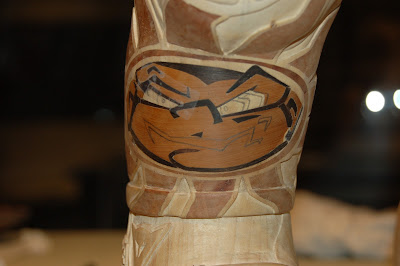I have many different carvings over the years that I want to put on this blog but carving generally is a slow business. It's very exciting at first, starting a piece, not knowing how it will eventually turn out, how well it may go. I want each piece I make to be better than the last, regardless of subject matter.
However, after the initial work, when the general shape has appeared, it becomes more methodical, slowly whittling down each element watching that I don't go too far, too thin, concentrating too much on one area without constantly relating to every other area. Little by little, all the elements slowly meld together to a point where I'm finally considering the sculpture as a whole. Now it gets exciting again, seeing the piece hinting at how it might end, but also at a point where ruin is a much more present possibility.
Anyway, point is,carvings take ages and following my progress on the veneers on Valentino's leg may begin to feel like watching paint dry. So I'll introduce some of my work interspersed with progress on the veneers.
Here is a horse anatomy study, carved in Limewood, taken from a plaster cast of a horse study when I did a term at the City and Guilds of London Art College many moons ago. This particular sculpture crops up all over the place.It may have gained popularity with the fashion for plaster casts two centuries ago around Europe which gave us such treasures as the cast rooms at the Victoria and Albert Museum.I've seen a copy at the Leighton House Museum. If you google "horse anatomy sculpture" various versions appear, I think most notably the Leonardo da Vinci horse in Grand Rapids, Michigan which seems to me to be the same pose but beefier and with skin.It may well be that the sculptor of the original may have been inspired by Leonardo's drawings for his giant bronze horse Il Cavallo
My carving isn't finished, interrupted by commissions and not returned to. I usually sand down my work as I generally aim at a sculpture that looks like the subject first and recognition of the material it is made in second. I don't like the "chiselly-sculpty" whittled look as a rule. Wood is a beautiful, warm and alive material and, in my humble opinion, doesn't need to have the gouged effect to reinforce that it is carved wood.
Having said that, because I usually sand my work, I wanted this horse to have all the tool marks and try my best to hide them with deft and nifty handwork LOL.Not there yet though. Lots of work still to do, but it's been so many years, I'd prefer to leave it as an unfinished study lurking on a shelf waving a powerful hoof in the air.
Saturday 12 May 2012
Wednesday 9 May 2012
Entering the digital age with a chisel and a mallet
Friends have told me to get online so finally I've taken the
plunge and started this blog to put some of my sculpture out into
the digital world.I've been sculpting,mainly in wood, for over 20 years and have carved a variety of different subjects over the years, relief carvings, animals, furniture. What I've chosen up until now to concentrate on is motorcycle racing as I've have had an interest in bike racing for many years (in fact, racing runs in the family ).I wanted to do contemporary carving rather than restoration or apeing older styles. After all, all the old styles were contemporary once! So I mixed the two together to see where it might go.
So let's just jump in to what I'm working on at the moment.
At the moment I'm veneering some graphics onto a figure I've been carving. This is a carving of Valentino Rossi, the MotoGP rider. This is my first portrait carving and has taken an age to complete.Getting it right without getting it wrong and learning to sculpt faces has made this the most challenging piece I've ever undertaken.The eyes have yet to be veneered and the hair will be stained and then the whole figure will be oiled.

This is Valentino Rossi, carved in Limewood standing 91cm in height. The veneers you can see are Yew for the face, Madrona burr for the suns rays and Indian Rosewood for the dark facial details.
The elements are built up bit by bit. Its not possible to create the whole image and afterwards apply it. The curve of the leg alters the relationship between each piece so they must be custom-fitted to match to it's neighbour then the hole is carved out to sink it into.
Almost finished.
So let's just jump in to what I'm working on at the moment.
At the moment I'm veneering some graphics onto a figure I've been carving. This is a carving of Valentino Rossi, the MotoGP rider. This is my first portrait carving and has taken an age to complete.Getting it right without getting it wrong and learning to sculpt faces has made this the most challenging piece I've ever undertaken.The eyes have yet to be veneered and the hair will be stained and then the whole figure will be oiled.
This is Valentino Rossi, carved in Limewood standing 91cm in height. The veneers you can see are Yew for the face, Madrona burr for the suns rays and Indian Rosewood for the dark facial details.
The elements are built up bit by bit. Its not possible to create the whole image and afterwards apply it. The curve of the leg alters the relationship between each piece so they must be custom-fitted to match to it's neighbour then the hole is carved out to sink it into.
Almost finished.
Subscribe to:
Posts (Atom)
